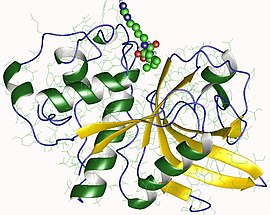| actinidain | |||||||||
|---|---|---|---|---|---|---|---|---|---|
 Biological assembly image of actinidain from Actinidia chinensis. From PDB: 1AEC. | |||||||||
| Identifiers | |||||||||
| EC no. | 3.4.22.14 | ||||||||
| CAS no. | 39279-27-1 | ||||||||
| Databases | |||||||||
| IntEnz | IntEnz view | ||||||||
| BRENDA | BRENDA entry | ||||||||
| ExPASy | NiceZyme view | ||||||||
| KEGG | KEGG entry | ||||||||
| MetaCyc | metabolic pathway | ||||||||
| PRIAM | profile | ||||||||
| PDB structures | RCSB PDB PDBe PDBsum | ||||||||
| Gene Ontology | AmiGO / QuickGO | ||||||||
| |||||||||
Actinidain (EC 3.4.22.14, actinidin, Actinidia anionic protease, proteinase A2 of Actinidia chinensis) is a type of cysteine protease enzyme found in fruits including kiwifruit (genus Actinidia), pineapple, mango, banana, figs, and papaya. This enzyme is part of the peptidase C1 family of papain-like proteases.[1][2][3][4]
As a known allergen in kiwifruit,[5] the enzyme is under preliminary research for its effect on tight junction proteins of intestinal epithelial cells.[6][7]
Actinidain is commercially useful as a meat tenderiser[8][9] and in coagulating milk for dairy products, like yogurt and cheese.[10] The denaturation temperature of actinidain is 60 °C (140 °F), lower than that of similar meat tenderising enzymes bromelain from pineapple and papain from papaya.[11]
- ^ Baker EN, Boland MJ, Calder PC, Hardman MJ (November 1980). "The specificity of actinidin and its relationship to the structure of the enzyme". Biochimica et Biophysica Acta (BBA) - Enzymology. 616 (1): 30–34. doi:10.1016/0005-2744(80)90260-0. PMID 7002215.
- ^ Kamphuis IG, Drenth J, Baker EN (March 1985). "Thiol proteases. Comparative studies based on the high-resolution structures of papain and actinidin, and on amino acid sequence information for cathepsins B and H, and stem bromelain". Journal of Molecular Biology. 182 (2): 317–329. doi:10.1016/0022-2836(85)90348-1. PMID 3889350.
- ^ Baker EN, Drenth J (1987). "The thiol proteases: structure and mechanism". In Jurnak FA, McPherson A (eds.). Active Sites of Enzymes. Biological Macromolecules and Assemblies. Vol. 3. New York: John Wiley and Sons. pp. 314–368. ISBN 978-0-471-85142-4.
- ^ Gul S, Mellor GW, Thomas EW, Brocklehurst K (May 2006). "Temperature-dependences of the kinetics of reactions of papain and actinidin with a series of reactivity probes differing in key molecular recognition features". The Biochemical Journal. 396 (1): 17–21. doi:10.1042/BJ20051501. PMC 1449998. PMID 16445383.
- ^ Maddumage R, Nieuwenhuizen NJ, Bulley SM, Cooney JM, Green SA, Atkinson RG (January 2013). "Diversity and relative levels of actinidin, kiwellin, and thaumatin-like allergens in 15 varieties of kiwifruit (Actinidia)". Journal of Agricultural and Food Chemistry. 61 (3): 728–739. doi:10.1021/jf304289f. PMID 23289429.
- ^ Grozdanovic MM, Čavić M, Nešić A, Andjelković U, Akbari P, Smit JJ, Gavrović-Jankulović M (March 2016). "Kiwifruit cysteine protease actinidin compromises the intestinal barrier by disrupting tight junctions". Biochimica et Biophysica Acta (BBA) - General Subjects. 1860 (3): 516–526. doi:10.1016/j.bbagen.2015.12.005. PMID 26701113.
- ^ Cavic M, Grozdanovic MM, Bajic A, Jankovic R, Andjus PR, Gavrovic-Jankulovic M (October 2014). "The effect of kiwifruit (Actinidia deliciosa) cysteine protease actinidin on the occludin tight junction network in T84 intestinal epithelial cells". Food and Chemical Toxicology. 72: 61–68. doi:10.1016/j.fct.2014.07.012. PMID 25042511.
- ^ Bekhit AA, Hopkins DL, Geesink G, Bekhit AA, Franks P (2014). "Exogenous proteases for meat tenderization". Critical Reviews in Food Science and Nutrition. 54 (8): 1012–1031. doi:10.1080/10408398.2011.623247. PMID 24499119. S2CID 57554.
- ^ Eshamah H, Han I, Naas H, Acton J, Dawson P (April 2014). "Antibacterial effects of natural tenderizing enzymes on different strains of Escherichia coli O157:H7 and Listeria monocytogenes on beef". Meat Science. 96 (4): 1494–1500. doi:10.1016/j.meatsci.2013.12.010. PMID 24447905.
- ^ Katsaros GI, Tavantzis G, Taoukis PS (January 2010). "Production of novel dairy products using actinidin and high pressure as enzyme activity regulator". Innovative Food Science & Emerging Technologies. 11 (1): 47–51. doi:10.1016/j.ifset.2009.08.007.
- ^ Tarté R (2008). Ingredients in meat products properties, functionality and applications. New York: Springer. ISBN 978-0-387-71327-4.